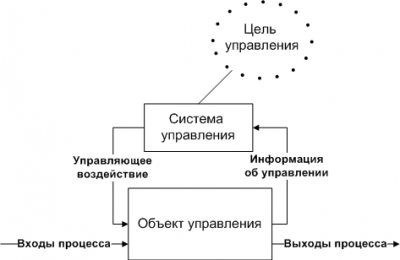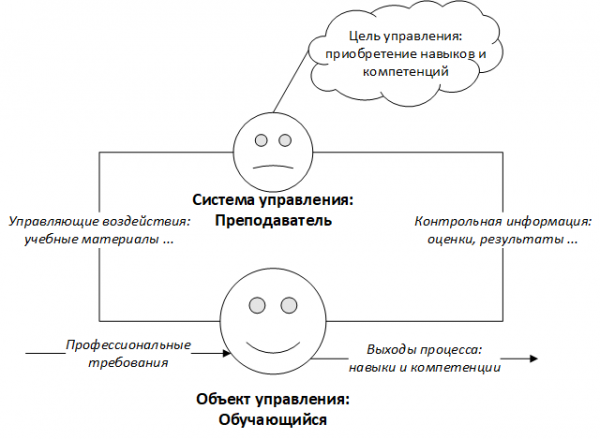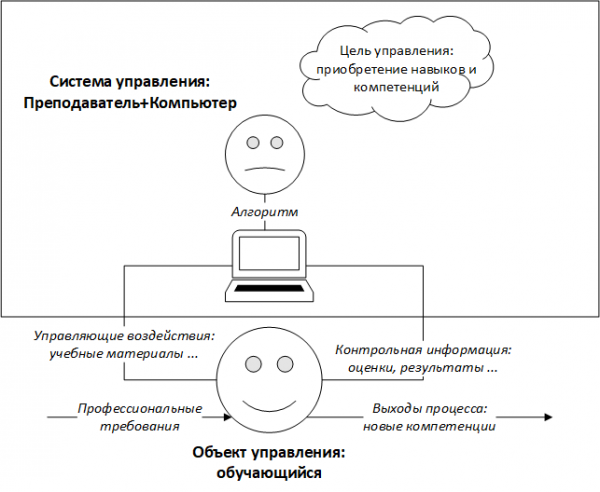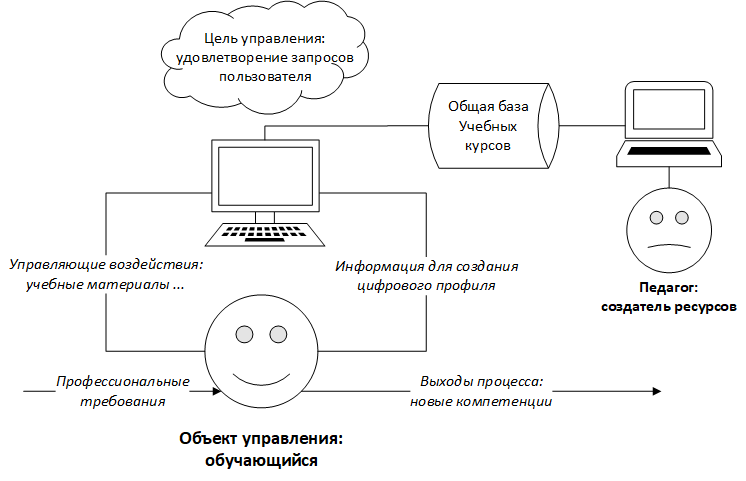|
DOI: 10.7256/2454-0676.2022.2.35657
EDN: MFFOKP
Received:
08-05-2021
Published:
04-07-2022
Abstract:
The article is devoted to the system justification of the e-learning process. The language of cybernetics is used to describe a purposeful process. Using the language of cybernetics allows you to identify all the components of the educational process management system. In the classical case, this is a teacher who has a management goal and achieves this goal. With the advent of computer technology, the process control system becomes more complicated – information and communication technologies are included in it. Based on the cybernetic model of learning as a purposeful process, the evolution of the interaction process in education from classical education in the form of "man-man", then to the form of "man-computer-man" and then to the form of "man-learning environment" is considered. At the same time, the evolution of the didactic content of the educational process is considered. The main conclusions of this study are: the conclusion that there is a fundamental contradiction between the finite possibilities of computer influence as part of the educational process management system and the infinite set of behavioral reactions of the learner. It is shown how this contradiction is resolved at the system level by, on the one hand, simplifying the e-course itself, but at the same time increasing the diversity of the number of courses. It is shown that at this level the development of e-learning and the content of digital didactics can be characterized as "student–teacher - learning algorithm". Further, a forecast is made that an increase in the variety of e-courses will lead to the creation of a personal learning environment, the purpose of which will be marketing: to satisfy the client's training needs as much as possible. It is concluded that digital didactics will be built on the principles of gamification.
Keywords:
digital didactics, e-learning, cybernetics, the learning process, control system, didactic triangle, didactics, pedagogy, training, algorithm
This article is automatically translated.
Introduction The observed transition to the information society and the introduction of information technologies have created conditions for the digitalization of all spheres of activity, including education. There is even a new term "digital didactics". At the same time, the contours of digital didactics are still being formed. An example is an article by V.I.Blinov with a characteristic title: "Digital didactics: a fashion trend or a new science?" [8]. Trying to determine the new content of didactics in the digital age, most researchers use an "ontological" - an essential approach based on attempts to predict how the essence of didactics will change under the influence of digital technologies. An example of such an approach is an article by E.Y.Shcherbina, O.V.Shmurygin and S.N.Utkin [21], which explicitly states that "the article is devoted to the problem of the essence of digital didactics of vocational pedagogical education." M.A.Choshanov's article is devoted to the content of didactics, in the metaphor of the "didactic triangle", and its transformation of the content of didactics under the influence of information technologies [20]. The article cited above by V.I.Blinov states: "A constructive approach is needed based on the construction of a new branch of pedagogical science – digital didactics, consistently using the basic concepts and principles of traditional (pre–digital) didactics as a science of learning - and at the same time complementing and transforming them in relation to the conditions of the digital environment." Actually, the development of a "constructive approach" to the construction of digital didactics is the subject of this article. The article uses an approach based on the understanding of learning as a purposeful controlled process. Therefore, the process can be approached from the point of view of cybernetics, as a science dedicated to the study of management processes. Thus, it is possible to study the transformation of didactics as a result of a change in the process control system. Let's move on to the description of the cybernetic paradigm of the educational process. Cybernetic paradigm of the educational process. Intuitively, it seems that learning is a purposeful process. However, the scientific understanding of learning as a purposeful process has taken shape within the framework of the direction known as pedagogical technologies. A.A.Faktorovich, describing the periodization of the formation of the direction "pedagogical technologies", refers to the 70s of the last century the use of a systematic approach to learning. "During this period, Spaulding notes that this technology includes: the process of setting goals, constant updating of curricula and programs, testing of curricula and programs, evaluation of pedagogical systems as a whole and the establishment of new promising goals when obtaining information about the effectiveness of the system" [18, p.6]. Understanding learning as a purposeful process allows us to use a cybernetic approach to describe the learning process. Cybernetics is a science "about the general laws of the processes of control and transmission of information in machines, living organisms and society" - Norbert Wiener [9]. Cybernetics focuses on how something (digital, mechanical or biological) processes information, reacts to it and changes or can be changed in order to better perform the first two tasks. It follows from this that cybernetics may well be used to analyze learning as a purposeful process, including on the basis of educational technologies [1]. To cybernetics we owe the universal control scheme shown in Figure 1. | 
| | Figure 1. Control process diagram | Figure 1 has all the components: the control object, the control system, the feedbacks, which were described by another prominent cyberneticist Kelly Kevin [5]. An important requirement for the management system is the law of necessary diversity formulated by Walter Ashby. According to Walter Ashby, "management can be provided only if the diversity of the manager's means (in this case, the entire management system) is at least no less than the diversity of the situation managed by him" [17]. Let's apply scheme 1 to the traditional learning process. In traditional educational technologies, the management system is a teacher who personally reacts to the course of the pedagogical process, as shown in Figure 2. The teacher is a person, manages the learner - a person. The whole variety of didactic means accumulated by pedagogy acts as a controlling influence, and information about the "object" of management includes not only formal indicators – assessments, but also a lot of informal ones, for example, behavior. The set of both control actions and information about management is unlimited. But the life and teaching experience of the teacher allowed us to hope that the variety of control actions is higher than the variety of reactions of the controlled system. Compliance with the law of necessary diversity is ensured. | 
| |
Figure 2. Educational process management scheme in the traditional educational paradigm. | Another thing is in electronic educational technologies. Management has a more complex structure, which is shown in Figure 3. Information and communication technologies (ICT) are used as a means of supporting and managing the educational process, as a means of creating, storing and delivering educational content and as a means of ensuring interaction between its participants. In its development, electronic educational technologies have gone from the creation of the simplest training courses delivered by e-mail, separate educational hypertext modules to the formation of remote centers with a set of training courses, performance analysis tools and methodological support for students, virtual universities and electronic educational spaces of individual educational organizations. In electronic educational technologies, the personal component is significantly reduced, the system is managed using formal procedures. At the same time, there are many control actions (a variety of didactic means) on the part of the computer is limited, and the variety of behaviors of the learner is unlimited. An illustration of this contradiction is protoring, a procedure for monitoring and controlling a remote test designed to limit the behavior of the learner. Actually, the question of this article is to assess the consequences of replacing the "design" of the control system in the pedagogical process. | 
| | Figure 3. Educational process management scheme in the e-learning paradigm. | The Didactic Triangle in digital Didactics The term "didactic triangle" began to form in the Middle Ages, but it was finally formulated by Chevalard in the formula "teacher-student-content" [2]. In the cybernetic model, when the set of control actions is countable, and learning is a purposeful process, we come to the conclusion that the sequence of training actions on the part of the computer is nothing more than an algorithm in its classical definition. "An algorithm is an exact prescription that sets a computational process (called algorithmic in this case), starting with an arbitrary source data (from a certain set of possible source data for a given algorithm) and aimed at obtaining a result completely determined by this source data" [15, p.9]. In the definition of the algorithm cited above, the understanding of the term as "exact prescription" is used. This just reflects the evolution in the definition of the algorithm from the early understanding of the algorithm as a strictly defined sequence of actions [10] to the modern understanding of the algorithm as an exact prescription that can be performed in one way or another. By itself, the spontaneity of human reactions is not a problem for computer algorithms, it is enough to bring the practice of computer games. Any computer game is essentially an algorithm to achieve a certain goal. The algorithmic approach to learning also changes the content of the didactic triangle, replacing the usual triad "teacher-student-content" with the following "teacher-student-learning algorithm". Literally, this happens as shown in Table 1. Table 1. The essential (traditional) and algorithmic approach to the educational process. | The traditional approach | Algorithmic approach | | Thematic curriculum | Electronic training course | | Topic 1. | Step 1. |
| Topic content 1. | A set of actions for mastering the topic 1 | | Topic 2 | Step 2 | | Content of topic 2 | A set of actions for mastering the topic 2 | | … | … | A typical algorithm for studying the material includes the following steps: - - obtaining initial information on the topic (such forms of information presentation as texts, presentations, videos are used);
- - feedback from the student of the course (forms such as tests and control tasks are most often used); this step may include communication between students and receiving a collective response;
- - making a decision to complete the study of the topic and move on to the next topic;
Actually, the difference is not so great, because in the traditional learning process, any textbook also contains control questions for each section and topic that the reader must answer after reading the section or chapter. The difference is more pronounced during the transition to e-learning and is expressed in how the result of intellectual activity on the creation of the course is interpreted. In the algorithmic approach, the result of creating a course is an algorithm. The most consistently algorithmic approach to the development of an electronic course is embodied in the LMS Moodle. LMS is a modular system [6], the modules include elements that ensure both the delivery of information to listeners and feedback in the form of completed tasks. In addition, there are many possibilities for automating the decision on admission to the next topic. Another manifestation of the difference between the traditional and algorithmic approach is manifested in the emergence of new roles: a teacher – the creator of an electronic course, and a tutor (assistant in LMS Moodle terminology), who accompanies students within a given algorithm. The algorithmic approach changes the listener's attitude to the course – it becomes procedural, i.e. the listener is primarily interested in the answer to the question: what should be done to complete the course. The cited article by E.Y.Shcherbina, O.V.Shmurygin and S.N.Utkin [21, p.415] suggests a block diagram of educational content in the discipline, which includes "1) introductory section; 2) content section; 3) final control" and then the block diagram itself. It is not difficult to see a certain similarity with Table 1 in the algorithmic approach. In M.A.Choshanov's article, the didactic triangle is transformed into a didactic tetrahedron taking into account technologies and one of the sections of the article is entitled "Teacher in the digital age: teacher-engineer" [20, p.688], which is fully consistent with the algorithmic approach to the development and content of the training course. In general, it can be concluded that the presented cybernetic model of the educational process does not contradict the traditional approach, but is more consistent and based on fundamental laws. The cybernetic approach also provides a forecast for the further development of digital didactics. From a separate course to the formation of a learning environment
Let's return once again to the contradiction formulated earlier between the finite (countable) set of managerial influences from the computer, and the uncountable possibilities of reaction to them from the listener. The law of necessary diversity in the case of a hierarchical control system was generalized by cyberneticist and philosopher E.A.Sedov [13]. He formulated the law of "hierarchical compensation". One of the most successful formulations belongs to Nazareth "in a complex hierarchical system, the growth of diversity at the upper level is ensured by limiting diversity at previous levels, and vice versa, the growth of diversity at the lower level [of the hierarchy] destroys the upper level of the organization" [11]. In our case, the hierarchical nature of the management system is demonstrated in Figure 3, where the formation of the learning algorithm is performed by the teacher – creator of the electronic course, which determines the purposeful nature of the process as a whole and information and communication technologies that ensure the progress of the process. It follows from the above that a decrease in diversity at the lower level (the level of information and communication technologies) should lead to an increase in diversity at the upper level, i.e. to an increase in the number of courses. Thus, the formulated contradiction is the reason (driver) for the increase in the number of electronic courses. The tendency to increase the number of courses will lead to the need for self-organization of the electronic learning environment, which will occur in two directions: structuring of courses and personalization of the system as a whole. Structuring of courses is expressed in the form of creating structural units from individual courses: profiles, programs, etc. The second direction of self–organization is personalization. Many agree with the conclusion about the formation of a personal learning environment. So V.A.Starodubtsev and A.A.Kiseleva derive their model from "the fundamental contradiction between the individual nature of the consumption (appropriation) of knowledge and the collective nature of production, including educational activities" [16]. Some researchers consider personalization to be a necessary quality of the educational environment. In the cited article by E.Y.Shcherbina, O.V.Shmurygin and S.N.Utkin, personalization is the basic principle of digital didactics [21, p.414]. The article by A.V. Slepukhin analyzes the concepts and differentiates the concepts of "personal learning environment", "personal learning environment", "personal learning environment" [14], based on the analysis of the works of other researchers. In order not to go into casuistry, let's look at the general trends in the field of personalization of the electronic environment and transfer them to the learning environment. The commercial prototype of personalization is the concept of "ecosystems", to which all the largest IT companies are switching: Sberbank, Yandex, Mail.ru and others. The motto of the Sberbank ecosystem is "We surround customers with convenient digital services for all occasions" [19]. The prototype of a personal learning environment is any modern search engine that personalizes the student's learning queries. As a result, we come to a new scheme of the educational process, as shown in Figure 4. | 
| | Figure 4. "Self-organization" of the training system and the transition to a learning environment. | In this scheme, the computer performs the following functions: creates and updates a digital portrait of the student based on his requests, provides the necessary training resources from the general database of e-learning courses, maintains and updates the database of e-learning courses. Due to the scaling, the purpose of managing the personal learning environment is changing: the purpose of management is to satisfy the user's requests for access to educational resources (electronic training courses). To verify the ideas expressed, a survey of the most popular educational portals was conducted. For each portal, 10 popular courses were taken, available on the front page of the course. Preference was given to courses from different sections in order to cover the entire topic of personal training. Next, the profiles of each course were viewed in order to extract the necessary information presented in Table 2. Since the Udemy portal does not provide an estimated time for completing the course, the duration of listening to the available audio and video materials was taken as an estimate, which can be considered as an estimate of the time of passing from below. The validity of such an estimate is confirmed by the fact that the time obtained is consistent with other estimates. On the Courserrs and edX portals, the estimated time is given in the form of an interval "from - to". In this case, the average value was taken. The "Open Education" platform provides the labor intensity of the course in credit units, which is recalculated during the standard ratio of 1 credit unit = 36 of the training time. Then, for the resulting sample of 10 values, the median was calculated as an estimate of the average. The values obtained are shown in Table 2. Similarly, the number of competencies of the course was taken from the profile of each course, except for the Udemy portal, which shows the number of learning outcomes that the student will receive after completing the course. For the resulting sample of 10 values of course competencies, the median of the sample was also calculated. Summary results are presented in table 2. Table 2. Characteristics of the largest educational platforms | Digital Learning Platform |
Number of courses | Structuring courses | Course success criteria | Average course completion time (hour) | Average number of competencies in the course | | 1 | 2 | 3 | 4 | 5 | 6 | | Udemy Training Portal Portal site [7] | 130 000 | Course categories, combining courses | Course rating: reviews + number of listeners | 18 | 11 | | Courserra platform. Portal site [3] |
51 000 | Course levels, courses on topics, students' specializations | Course rating: reviews + number of listeners | 19 | 6 | | Non-profit educational platform edX. Portal site [4] | 3 000 | Courses on topics, programs for students | Course rating: | 30 | 6 | | Educational platform "Open Education". Platform website [12] | 723 | Courses on the following topics | No data available | 108 | 5 |
First of all, it is necessary to characterize the platforms: one of the functions of the Open Education platform is to "exchange" courses with other educational institutions, therefore, the characteristics of the courses posted on this platform are closest to the characteristics of courses for traditional education. From the comparison of the data in columns 2 and 5, we see a tendency that the average course completion time tends to decrease, but this trend is offset by an increase in the number of courses in accordance with the stated theoretical provisions. We also observe various ways of structuring courses (column 3). Column 4 presents data confirming the conclusion that when forming a learning environment, the purpose of learning becomes not didactic, but commercial. What serves as a justification for scheme 4. The data presented in column 5 are interesting, from which it follows that the number of competencies that a student acquires during the study of a particular course remains constant (or even tends to increase), despite the shorter time that needs to be spent on studying the course. The data indicate the effectiveness of the personal learning environment and the effectiveness of the training tools provided by digital didactics. The reason for the effectiveness of digital didactics is that the personal learning environment is designed to meet the user's needs for acquiring new competencies in the most comfortable way. The principle of maximum comfort can be provided only if psychological mechanisms related to the needs of the student are included, for which various methods of gamification of the learning process are used. The inclusion of psychological mechanisms of involvement in the educational process makes it possible to increase the effectiveness of the educational process. However, the use of engagement and gamification has a downside. Everyone knows the low percentage of those completing mass open courses. The personalization of the educational environment will also change the content of digital didactics – the didactic triangle. With the advent of a personal digital environment, the didactic triangle will take the form of "student - personal learning environment – satisfaction of learning needs". Conclusion The article considered the evolution of digital didactics based on the system laws underlying cybernetics – the science of management. It is shown that the introduction of information and communication technologies into the learning process leads to a fundamental contradiction between the finite capabilities of computer technology and the infinite variety of behavior of the learner. It is shown how this contradiction is resolved: first in the form of increasing the variety of courses offered, then in the transition to a personal learning environment. The evolution of the digital didactic environment is also considered in the context of system evolution.
References
1. Alexander Gushchin, Marina Divakova Trends of E-education in the Context of Cybernetics Laws // Procedia-Social and Behavioral Sciences. December 2015. 214:890-896
2. Chevallard Y. Pourquoi la transposition didactique? (Why didactic transposition?) // Seminar in Didactics and Pedagogy of Mathematics. +IMAG. University of Grenoble. pg.8.1982. pp. 167-194.
3. Coursera: sait. URL:https://www.coursera.org/ (data obrashcheniya 05.05.2021)
4. edX:sait. URL:https://www.edx.org/ (data obrashcheniya 05.05.2021)
5. Kelly Kevin. Out of control: the new biology of machines, social systems and the economic world. Boston: Addison-Wesley, 1994.
6. MoodleDocs // moodle:sait. URL:https://docs.moodle.org/310/en/Main_page (data obrashcheniya 05.05.2021)
7. Udemy; sait. URL:https://www.udemy.com/ (data obrashcheniya 05.05.2021)
8. Blinov V. I. Tsifrovaya didaktika: modnyi trend ili novaya nauka? // Sovremennye problemy professional'nogo i vysshego obrazovaniya: sostoyanie i otsenka. 2019. s.14-24.
9. Viner N. Kibernetika ili upravlenie i svyaz' v zhivotnom i mashine [Tekst] : [Per. s angl.] / [Predisl. G. N. Povarova, s. 5-28].-2-e izd.-Moskva: Sov. radio, 1968.-326 s.
10. Krupskii V. N., Plisko V. E. Teoriya algoritmov. M.: Academia. 2009. 208s.
11. Nazaretyan A.P. Informatsionnye krizisy v kontekste universal'noi istorii. M.; Mir. 2004. 225s.
12. Otkrytoe obrazovanie: sait. URL:https://openedu.ru/ (data obrashcheniya 05.05.2021)
13. Sedov E.A. Informatsionnye kriterii uporyadochennosti i slozhnosti organizatsii struktury sistem. // Sistemnaya kontseptsiya informatsionnykh protsessov. M.: 1988. ¹3.
14. Slepukhin A. V. Ispol'zovanie personal'noi obrazovatel'noi sredy v protsesse individualizatsii smeshannogo obucheniya studentov // Pedagogicheskoe obrazovanie v Rossii. 2014. ¹. 11. c.195-205
15. Sovremennye obrazovatel'nye tekhnologii: uchebnoe posobie / kollektiv avtorov; pod red. N.V. Bordovskoi.-2-e izd., ster. M.: Knorus. 2011. 432 s.
16. Starodubtsev V. A., Kiseleva A. A. Personal'naya obrazovatel'naya sfera pedagoga kak sreda professional'noi deyatel'nosti // Shkol'nye tekhnologii. 2011. ¹. 5. c.85-89.
17. Uolter Eshbi. Vvedenie v kibernetiku, M.:«Inostrannaya literatura», 1959.429c.
18. Faktorovich A. A. Pedagogicheskie tekhnologii // M.: Izdatel'stvo Yurait. 2017. 128 c.
19. Tsifrovaya ekosistema Sbera // Sberbank:sait. URL:https://www.sberbank.com/ru/eco (data obrashcheniya 05.05.2021)
20. Choshanov M. A. E-didaktika: Novyi vzglyad na teoriyu obucheniya v epokhu tsifrovykh tekhnologii //Obrazovatel'nye tekhnologii i obshchestvo. – 2013. – T. 16. – ¹. 3. c. 684-695
21. Shcherbina E. Yu., Shmurygina O. V., Utkina S. N. Tsifrovaya didaktika professional'no-pedagogicheskogo obrazovaniya: osnovnye komponenty //Biznes. Obrazovanie. Pravo. 2020. ¹. 2. s.411-418.
|
















 This work is licensed under a Creative Commons Attribution-NonCommercial 4.0 International License.
This work is licensed under a Creative Commons Attribution-NonCommercial 4.0 International License.

